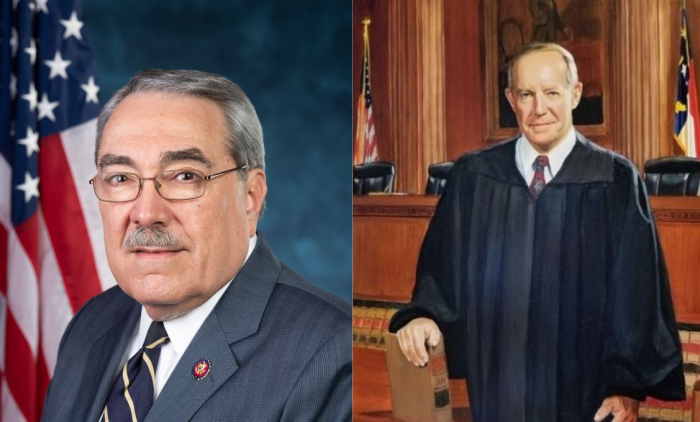The racially fraught history of North Carolina's unique redistricting process

U.S. Rep. G. K. Butterfield (left) served on the North Carolina Supreme Court and dissented when his Republican colleagues established a new redistricting process in 2002. Chief Justice I. Beverly Lake Jr. (right) wrote the opinion. (Photo from Butterfield's office; Lake's official portrait.)
When the 2020 census results were released last week, the Republican-controlled North Carolina legislature had already kicked off the redistricting process. When legislators redraw their own districts, they will use a complicated process that's unique to North Carolina and is intended to balance the conflicting demands of the Voting Rights Act of 1965 and a 1968 state constitutional amendment that conflicted with the VRA.
Three years after Congress passed the VRA and outlawed racial discrimination in voting, North Carolina voters passed an amendment to the state constitution that made it impossible for Black voters in many urban counties to elect legislative candidates of their choice.
The amendment — drawn up by an all-white legislature and approved by an electorate shaped by Jim Crow voting policies — said that legislators couldn't split counties when drawing legislative election districts. Under this system, an urban county would have several representatives elected at large, rather than from separate districts within the county. Multimember legislative districts are prohibited by the VRA in many states, since Black voters in cities were typically outnumbered by white voters in countywide elections.
The North Carolina legislature applied the amendment during redistricting in 1971, and the multimember districts remained in place throughout the 1970s. Lawmakers didn't submit the amendment to the federal government for "preclearance," as the VRA required, until 1981. When they did, the Reagan administration blocked it, with the Department of Justice concluding that the use of multimember districts "necessarily submerges" Black voters into larger, white districts. State lawmakers redrew districts without the amendment in force in 1982, and the number of Black legislators increased from six to 13.
Then in 1986, in a redistricting case out of North Carolina, the U.S. Supreme Court laid out a formula for determining which communities need what legislators today refer to as "VRA districts." These are districts where map drawers must ensure that communities of color have the power to elect their preferred candidates. The formula considers factors like demographics and racial polarization in voting. The state legislature began including VRA districts in the map drawing process and stopped applying the 1968 amendment.
But in 2002 the North Carolina Supreme Court resurrected it in a case challenging Democratic-drawn legislative districts. Stephenson v. Bartlett was a lawsuit by a group of Republican legislators including Art Pope, a powerful GOP donor with libertarian views on race who then served in the state House. The court's Republican majority ordered the Democratic-led legislature to draw new districts complying with the amendment, except where they have to split counties to draw VRA districts. The order in Stephenson came less than five months after the legislature drew the districts and after filing for the next primary election had already begun.
The decision was written by Chief Justice I. Beverly Lake Jr., whose father had been a segregationist candidate for governor but who himself went on to champion criminal justice reforms that addressed racial bias. As Lake noted at the time, the Department of Justice said that its objection to the amendment shouldn't be interpreted as precluding "a policy of preserving county lines whenever feasible." The new court-ordered districts laid the groundwork for the Republican takeover of the legislature years later.
The two Democratic justices dissented, arguing the "whole county" amendment was unconstitutional. Justice G. K. Butterfield, a Black Democrat who now serves in Congress, wrote a powerful dissent. "My view of the people's intent does not include the sacred nostalgia for whole counties that the majority seems to embrace," he said. Butterfield denied that the 1968 amendment "represented the will of all of the people," noting that the electorate at the time excluded Black people who were legally eligible to vote but blocked from registering. Justice Bob Orr, then a Republican who later became a Trump critic and left the GOP, filed a partial dissent accusing his Republican colleagues of trying to "micromanage" redistricting.
I discuss the redistricting system that came out of the Stephenson ruling in my book, "Usurpers: How Voters Stopped the GOP Takeover of North Carolina's Courts," writing:
The court laid out a new process, unique to North Carolina, that legislators must follow to reconcile the whole county amendment and the VRA. Legislators would start by drawing the districts required by the VRA, while complying with the amendment as much as possible. Then, they would implement the amendment for the rest of the districts. For counties large enough for multiple districts, all the districts would be within the county. Smaller counties would be combined into clusters … and the clusters would be divided into districts.
For the next decade, North Carolina's legislative elections seemed fairer to the two major parties than in the past, when many districts had been drawn to favor Democrats. Each party's portion of the votes roughly translated to a similar portion of legislative seats.
In 2010, with the national GOP focused on winning control of legislatures before the next redistricting cycle, Republicans won big in the redrawn districts and secured a majority in both chambers of the legislature for the first time since Reconstruction. Democrats argued at the time that Republicans violated Stephenson by splitting too many counties, but the North Carolina Supreme Court, which still had a Republican majority, rejected that argument.
The gerrymandered post-2010 districts, which led to a veto-proof Republican supermajority, faced legal challenges. State and federal courts repeatedly ordered the legislature to redraw them. Federal judges struck down the districts for discriminating against Black voters, but the new districts were still biased against Democrats. In 2019, state courts struck these districts down and ruled that extreme partisan gerrymandering violates the North Carolina Constitution.
In the redistricting process now underway in North Carolina, the requirement to avoid splitting counties or "county groupings" will complicate things. Two Republican consultants, Jim Blaine and Ray Martin, recently estimated the possible county groupings. They found that, despite a population boom in the state's urban areas, the county groupings mean that "Republicans almost certainly will retain a majority in the House and have a very good chance at winning a supermajority."
In addition to the partisan impact, the Stephenson process could limit the influence of voters of color who aren't in VRA districts. In other words, a legislature can engage in racial gerrymandering without violating the VRA. And the Stephenson process itself is the result of a long quest to avoid complying with a landmark voting rights statute.
Tags
Billy Corriher
Billy is a contributing writer with Facing South who specializes in judicial selection, voting rights, and the courts in North Carolina.
